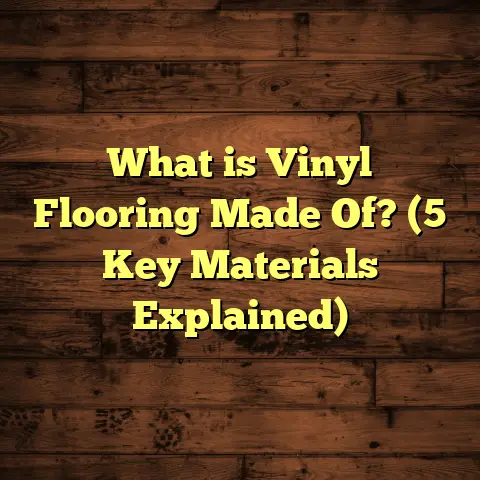What is a Floor Scrubbing Machine? (5 Key Benefits Explained)
Spring cleaning season is almost here, and if you’re anything like me, that means it’s time to pull out all the stops to get my floors sparkling again. Over the years, I’ve tried everything from mops to steam cleaners, but one tool that has truly changed how I tackle floor maintenance is the floor scrubbing machine. If you haven’t heard of it or just don’t know what it does, don’t worry—I’m going to walk you through exactly what a floor scrubbing machine is and why it might be the best investment for your home or business.
What Is a Floor Scrubbing Machine?
So, what is a floor scrubbing machine? Simply put, it’s a power tool designed to clean large floor surfaces efficiently by scrubbing dirt, grime, and stains away. It looks like a mix between a vacuum cleaner and a small floor polisher. But unlike a mop or broom, this machine uses rotating brushes or pads combined with water and cleaning solution to deeply clean floors.
The idea behind it is straightforward: instead of manually scrubbing floors (which can be exhausting and time-consuming), the machine does the heavy lifting. You push or guide it over your floor, and the rotating brushes scrub away dirt while suction or mop pads pick up the dirty water. The result? A much cleaner floor in a fraction of the time.
From commercial spaces like schools and hospitals to residential garages and basements, these machines come in different sizes and types to suit different needs. Some are walk-behind models perfect for medium-sized areas, while others are ride-on machines designed for huge spaces like warehouses.
How I Discovered Floor Scrubbers
When I first started in flooring maintenance, I relied heavily on manual cleaning. I remember spending hours scrubbing stubborn stains on tile floors after big family gatherings. It was tiring and, honestly, frustrating when the floors still didn’t look as good as I wanted.
Then I tried a floor scrubbing machine at a client’s warehouse. The difference was night and day. What took me hours before was done in less than 30 minutes—and the floor looked professionally cleaned. Since then, I’ve added a few different models to my toolkit because they make my work easier and more effective.
5 Key Benefits of Using a Floor Scrubbing Machine
You might be wondering: is it really worth it? Here are five big reasons why I think floor scrubbing machines are game changers.
1. Saves Time and Effort
Imagine scrubbing a gymnasium floor by hand—sounds exhausting, right? That’s where these machines shine. They cut down cleaning time dramatically.
In fact, studies show that floor scrubbing machines can reduce cleaning time by up to 70% compared to manual methods. This is because the machine’s brushes cover more ground quickly and scrub more thoroughly without tiring you out.
For example, I recently cleaned a 2,000 square foot commercial kitchen floor that usually takes me around 3 hours to mop and scrub manually. Using a floor scrubbing machine, I finished in about an hour. That’s a huge efficiency boost!
I remember another time when I helped clean an office building before an inspection. The floors were dull and had dirt build-up in corners. With the scrubbing machine, I got everything looking spotless in a fraction of the time it would have taken doing it by hand—and the client was thrilled with the results.
2. Provides Deeper Clean
Mops can only do so much—they often just move dirt around or push it into grout lines and corners. Floor scrubbers agitate the floor surface with specialized brushes that can reach nooks and crannies better.
Data from cleaning industry reports highlight that floors cleaned with scrubbers generally have 30-50% fewer bacteria compared to traditional mopping. This is especially important in places that require high sanitation like hospitals or food prep areas.
When I used a floor scrubber on my own kitchen tile floor, I noticed that stains from pet accidents disappeared much more effectively than before.
The brushes’ rotation physically breaks down dirt particles embedded in grout or textured flooring surfaces—something mops struggle with. Plus, many scrubbers allow you to adjust brush pressure depending on your floor type, so you get just the right amount of scrubbing power without damaging surfaces.
3. Reduces Water Usage
You might think using a machine means more water, but actually, many modern floor scrubbers use significantly less water than mopping.
Some models use as little as 0.1 gallons per minute, while mopping can waste gallons of water without proper wringing techniques. Less water means quicker drying times too—which helps prevent slips and damage to sensitive flooring materials.
In my experience working on hardwood floors, this precise water control has been essential to avoid warping or swelling—a common problem when floors get too wet.
I recall working on a large retail store with delicate laminate flooring. Using traditional mopping methods always left puddles that took forever to dry and occasionally caused water damage. Switching to a scrubber cut down water usage by nearly half and kept floors dry faster.
4. Enhances Safety
Wet floors are notoriously slippery and hazardous. With mopping, you often leave puddles behind that take time to dry.
Floor scrubbing machines often come with suction systems that vacuum up dirty water immediately after scrubbing. This leaves floors drier faster and safer for foot traffic.
At one commercial site I serviced, the facility manager told me slip-and-fall incidents reduced by over 60% after switching to machine cleaning. That kind of safety improvement is hard to ignore.
Also, many scrubbers have adjustable speeds or eco modes that reduce water output further enhancing safety by minimizing wetness on floors during cleaning.
5. Cost-Effective Over Time
While the initial investment in a floor scrubbing machine might seem high (prices range from $500 for small units up to $15,000 for industrial ride-ons), they save money in the long run.
How? Less labor time means lower cleaning costs. Also, because floors are cleaned more thoroughly and regularly, they last longer—delaying expensive repairs or replacements.
I often use tools like FloorTally to estimate costs when planning projects that include floor installation or maintenance. It helps me budget accurately by considering labor, materials, and equipment costs—floor scrubbers included—which makes decision-making clearer and less stressful.
For example: If you’re budgeting to clean 10,000 square feet regularly, even saving just 2 hours per cleaning session with a scrubber translates into significant labor cost savings annually.
Different Types of Floor Scrubbing Machines
Understanding what kind of floor scrubbing machine suits your needs is crucial before buying one. Here’s a breakdown of some common types:
Walk-Behind Scrubbers
These are popular for medium-sized areas like retail stores or offices. You walk behind them pushing the machine forward while it cleans.
They tend to be lightweight and easy to maneuver around furniture. Battery-powered models offer freedom from cords which is great for bigger spaces or spots without close outlets.
I use walk-behind scrubbers most often for residential jobs or smaller commercial spaces because they balance power with portability nicely.
Ride-On Scrubbers
These are larger machines intended for very big spaces like warehouses or airports where covering ground quickly is necessary.
You sit on these machines and drive them like a small vehicle while cleaning as you go. They have bigger tanks for cleaning solutions and wastewater meaning fewer refills during use.
Once I had to clean a distribution center’s 50,000 square foot floor overnight before inventory audits started next day. A ride-on scrubber was essential because it allowed me to finish in hours instead of days.
Handheld Scrubbers
Smaller and more versatile for tight spaces or spot-cleaning stubborn stains on stairs or corners.
Though not suitable for large areas due to limited capacity, they are great for quick touch-ups or areas where larger machines can’t reach.
I keep one handheld scrubber in my kit for emergency cleanups during jobs—it’s saved me many times when spills happen unexpectedly.
How Floor Scrubbers Work: The Mechanics Behind Clean Floors
Understanding how these machines work can help you appreciate their value even more.
Brushes and Pads
At the heart of every floor scrubbing machine are the brushes or pads rotating rapidly against the floor surface.
- Rotary brushes: Spin in circles breaking up dirt.
- Orbital pads: Move in tiny circles offering gentler cleaning ideal for sensitive floors.
- Cylinder brushes: Roll forward like a rolling pin—great for uneven surfaces like concrete.
Each type targets different dirt types and floors. Most machines let you swap these heads out depending on your cleaning needs.
Cleaning Solution Dispensing
The machine sprays a controlled amount of cleaning solution mixed with water onto the floor right before brushing starts its work. This loosens grime making it easier for brushes to scrub away dirt particles effectively.
Vacuum/Suction System
After scrubbing loosens dirt and debris, the suction system sucks up dirty water instantly leaving floors nearly dry as soon as you finish cleaning that area.
This system prevents puddles from forming which reduces slip hazards and shortens drying times dramatically compared to mopping alone.
Common Flooring Types That Benefit From Floor Scrubbers
Not all floors respond equally well to every cleaning method—knowing which flooring types benefit most from scrubbing machines can guide your choice.
Tile Floors
Ceramic or porcelain tiles with grout lines often trap dirt deep within cracks where mops struggle to reach effectively.
Scrubbers’ rotating brushes agitate grout lines thoroughly removing hidden dirt buildup restoring shine and cleanliness better than manual methods ever could.
I worked on several schools where tile floors had years of neglected grime buildup; using scrubbers restored them beautifully without expensive re-grouting needed afterward.
Concrete Floors
Industrial concrete floors tend to accumulate grease and oil stains heavy-duty brushes on floor scrubbers break down these tough soils better than mopping ever would.
They also prepare concrete well before sealing or painting which extends surface life significantly.
Vinyl and Linoleum
These resilient floors benefit from gentle pad options that clean without scratching finishes while removing scuffs and marks effectively.
Because vinyl can be sensitive to excess water, scrubbers’ controlled moisture release helps prevent damage common with traditional mopping methods.
Hardwood Floors (With Caution)
Hardwood floors require careful handling—too much water or abrasive action damages finishes fast.
Some manufacturers produce specialized soft-bristle pads designed specifically for hardwoods allowing gentle cleaning without harm if used properly with correct solution dilution.
I always check manufacturer guidelines before using any scrubbing machine on wood floors; it’s all about balance between cleanliness and protection.
Maintenance Tips for Your Floor Scrubber
Owning a floor scrubbing machine means keeping it in good shape so it works well for years:
- Clean brushes/pads after each use.
- Empty wastewater tanks promptly.
- Check batteries regularly if cordless.
- Inspect hoses/suction system for clogs.
- Store in dry place to avoid rust or mold growth.
- Follow manufacturer’s service schedule for motor upkeep or part replacements.
Keeping up with maintenance prevents breakdowns during critical jobs—a lesson I learned early after one machine failed mid-cleaning due to neglected filter clogs!
My Experience Using FloorTally To Estimate Costs For Flooring Projects
As someone heavily involved in flooring installation and maintenance projects, estimating costs accurately is vital—not just for me but also for clients who want transparency regarding budgets.
Tools like FloorTally have been incredibly helpful by consolidating material prices, labor costs, equipment expenses (including floor scrubbing machines), and waste factors into one place.
When planning new floor installations or refurbishing existing ones, I enter measurements along with preferred materials into FloorTally which then provides detailed cost breakdowns based on local rates—making budgeting easier and reducing surprises mid-project.
For example: estimating how much labor time will reduce due to using a floor scrubbing machine versus traditional cleaning helps justify equipment investments upfront based on projected savings long term.
Addressing Common Questions About Floor Scrubbing Machines
Are floor scrubbers hard to operate?
Not at all! Most modern machines are designed with user-friendly controls—think easy start/stop buttons and adjustable settings for speed or brush pressure. Many come with manuals or training videos too.
When I introduce clients or staff members to these machines, I always demonstrate operation hands-on which builds confidence quickly even for beginners.
Can I use a floor scrubbing machine on carpet?
Nope—these machines are designed specifically for hard surfaces like tile, concrete, vinyl, or wood floors. Carpet requires different equipment such as carpet extractors or steam cleaners tailored for fabric fibers.
How often should I use a floor scrubbing machine?
It depends on foot traffic and environment but typically once every 1-2 weeks in commercial settings keeps floors looking good. For homes with pets or kids, more frequent use might be beneficial especially in high-traffic zones like kitchens or entryways.
Final Thoughts
If you want cleaner floors faster with less physical effort—and potentially save money long term—a floor scrubbing machine is definitely worth considering this spring cleaning season (or any time of year).
Their ability to deep clean various flooring types while controlling water use and improving safety makes them valuable tools whether you’re managing a business facility or simply want immaculate floors at home with less hassle.
Feel free to reach out if you want help selecting one or have questions about maintenance tips! With the right approach and tools like FloorTally to keep your projects on budget, achieving spotless floors has never been easier—or smarter.





